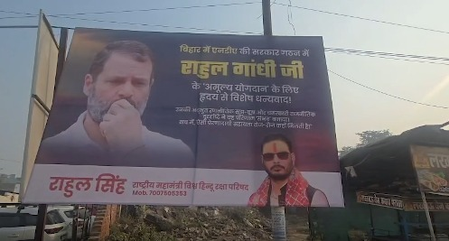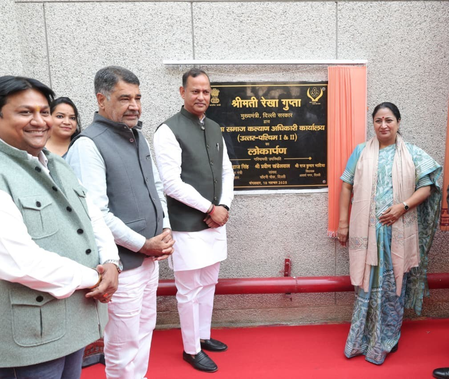
Raebareli, Nov 19 (IANS) A poster war has erupted in Leader of Opposition (LoP) in the Lok Sabha Rahul Gandhi’s parliamentary constituency after a Vishva Hindu Parishad (VHP) leader on Wednesday put up posters thanking the Congress MP for the National Democratic Alliance’s (NDA) victory in Bihar.
The posters sarcastically praise the LoP stating: “For the formation of the NDA government in Bihar, heartfelt thanks for Rahul Gandhi’s priceless contribution. His incredible strategy, prudence, and miraculous foresight made this possible. We should receive such motivational support every day.”
The NDA had recently secured a sweeping win in the Bihar Assembly elections, capturing over 200 of the 243 seats. Within the alliance, the BJP won 89 seats and the Janata Dal (United) secured 85. An interactive feature shows the detailed results of the 2025 Bihar elections, with options to view data through maps and charts. Results from the 2015 and 2020 Assembly elections are also included for comparison.
The NDA’s total vote share stood at 46.7 per cent, while the Opposition alliance registered 37.5 per cent.
The Congress has faced a major defeat in the Bihar Assembly elections, managing to win only six seats. A key highlight of the RJD–INC campaign was party LoP Gandhi’s ‘Vote Chori’ pitch. His extensive travel across the state was intended to influence 116 Assembly seats.
The aggressive campaign of the INDIA Bloc, known as the Mahagathbandhan in Bihar, centered around the Congress MP’s ‘vote chori’ allegations. Yet, the pitch appears to have fallen flat with voters, as trends indicated a record NDA victory in the 2025 Bihar Assembly elections.
For the Congress, the trends are particularly sobering. The party not only underperformed in the seats it contested but also failed to contribute meaningfully to the alliance tally.
Despite repeatedly raising allegations such as ‘voter chori’ against the Centre and the Election Commission, and campaigning around the Special Intensive Revision (SIR) drive and the ‘Voter Adhikar Yatra’, the Congress struggled to gain traction on the ground.
In the last press conference on ‘Vote Chori’ on November 6, Rahul Gandhi claimed to show evidence of a Brazilian model appearing on the Haryana voter list 22 times under different names, including Seema and Sweety.
LoP Gandhi’s ‘vote chori’ pitch, along with the Congress’ high-energy social media campaign expected to energise cadres and consolidate anti-incumbency, did not create the momentum the party had hoped for.
Promising a ‘hydrogen bomb’ of evidence but never fully delivering it, Rahul Gandhi held three press conferences where he presented alleged proofs of how the ECI was enabling vote theft, mass deletion of votes, and data manipulation.
On November 6, LoP Gandhi again repeated his “vote chori” allegation while appealing to what he called “Gen Z brothers and sisters” to decide Bihar’s future. But this strategy also failed to resonate with voters.
In the 2020 elections, Congress secured 27 seats out of 70, with a conversion rate of 38 per cent. This time, however, its performance has dropped even further.
Congress once a dominant force in Bihar’s political landscape, has gradually lost its hold over the state. In 2025, it contested as a junior partner in the alliance with the Rashtriya Janata Dal (RJD). The 2025 Bihar election results mark one of the party’s weakest showings.
Congress was once among the top three political parties in Bihar, especially before the state’s bifurcation in 2000. In the 1985 elections, Congress won a clear majority with 196 seats, leading to Chandrashekhar Singh becoming Chief Minister.
In the 1990 elections, Congress emerged as the second-largest party with 71 seats, considered its last strong performance. The party’s final phase of prominent leadership came under Jagannath Mishra, who served as Chief Minister in 1990.
However, the party’s influence declined rapidly thereafter. In the 1995 elections, its tally fell sharply to 29 seats, marking the beginning of a long-term slide.
In 2000, Bihar was bifurcated to create the new state of Jharkhand. This dramatically reshaped Bihar’s political landscape, enabling the rise of regional parties such as the Janata Dal (United) and the RJD. In the 2000 Assembly elections, held before bifurcation, Congress finished fourth with 23 seats.
–IANS
jk/rad




